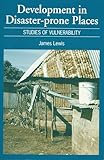Development in disaster-prone places : studies of vulnerability / James Lewis.
Material type: TextPublication details: London : Intermediate Technology Publications Ltd. , 1999.Description: 174 pISBN:
TextPublication details: London : Intermediate Technology Publications Ltd. , 1999.Description: 174 pISBN: - 1853394726 (pbk)
- 363.34 21
| Item type | Current library | Collection | Call number | Status | Date due | Barcode | |
|---|---|---|---|---|---|---|---|
 Books
Books
|
Australian Emergency Management Library | BOOK | 363.34 DEV (Browse shelf(Opens below)) | Available | 011199561 |
Browsing Australian Emergency Management Library shelves, Collection: BOOK Close shelf browser (Hides shelf browser)
Includes bibliographical references and index.
This book addresses the long-overdue imbalance in disaster management: an over-emphasis on post-disaster assistance and a lack of attention to vulnerability reduction. It answers the fundamental question in this debate: how can we mould pre-disaster development initiatives in order to reduce vulnerability? The book reasserts and reapplies some of the basic concepts and issues which emerged in the 1960s and 1970s, with the message that development is a prime medium both of vulnerability and its reduction. The author examines requirements for long-term change so that conditions which have become the context for catastrophe can be modified. By focusing on longer-term policies and activities now, emergency relief efforts will have a positive context within which to contribute to development, and the likelihood of recurrence will be reduced. Contains case studies from Sri Lanka, the Caribbean and the South Pacific and focuses on hazards of all kinds, setting out to redress the balance between large-scale disasters of global significance and small-scale disasters that are a matter of everyday existence
There are no comments on this title.





